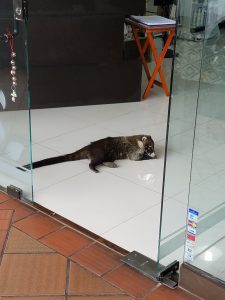Cuanto Cuesta? (It costs how much?)
Ok, so you remember how I told you that Costa Rica is a great place to live because, as well as the natural beauty and the nice people, it was cheaper than life in the US? Well, it’s time to clarify that statement.
We gringos assume that life in Mexico and Central America is less expensive; and in many instances it is. Nicaragua, for example, is a real bargain, as are parts of Mexico. Costa Rica, however, is different.
I have seen many videos encouraging older Norteamericanos to retire to CR. Two claims that are made are 1) that life is cheaper and 2) that you can find all your favorite American brands. While these statements are both true, together they constitute a lie: Life is in many ways cheaper, but if you want to buy American, it’s going to cost you an arm and a leg.
Now, on one hand, services are much cheaper here; basically because the locals, who earn much less than US workers, need electricity, water, cell phone, cable, etc. I was delighted to learn that I was saving more than $500 per month on those alone. And rent can be cheaper as well. Things and food, however, are the same if not more than in the US. This fact has sent many Americans running back to the States feeling like they’d been had.
For example, upon my arrival, I went shopping and bought brands of food with which I was familiar. Not yet used to the money here, I did not at first realize how much I was spending. The chicken broth which I pour over my dog’s dinner costs under $2 at Trader Joe’s, my market of choice in California. Imagine my surprise when I realized I was paying close to $7 for it here.
So, I set about learning how to live like a Tico (Costa Rican). First of all, no more trips to Automercado and Fresh Market, which are supermarkets aimed at the expat community. WalMart is cheaper (it is a major food market here), and Pali is the cheapest, with no air conditioning and local brands. As in the US, there are street markets; unlike the US, there are people who drive around in their cars with loudspeakers selling all kinds of necessities.
In the local Multiplaza, which is a mall with all the stores you see in North American malls. (It is important not to refer to oneself as an American, since Costa Rican prides itself on also being part of the American continent.) However, the prices are similar if not more than those in the US.
Transportation is cheaper, as with Uber and buses, and car and health insurance and much cheaper (again, because the locals all have to have them). An interesting item about car insurance is that it can cover repairs and services not having to do with accidents.
Finally, the biggest factor in how to save money is where on lives. Typically, expats are more comfortable around other expats and near businesses where English is spoken; I have a neighbor who has lived on my street for five years and has never learned Spanish. However, keep in mind that foreigners have bought up the properties and charge US prices when renting to fellow gringos. What can I say: There goes the barrio.
Renting in Escazu, which is the Beverly Hills of Costa Rica, though costly, is a good idea for the first year. All services are available and within a 10-minute ride, and there are several Spanish language schools. Once acclimated to the language and culture, however, I plan to move out to a smaller, more authentic and beautiful town. Tres Rios, maybe? I’ll keep you posted.


